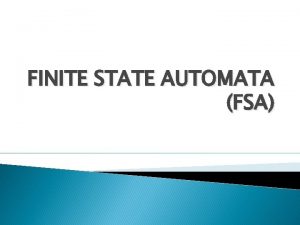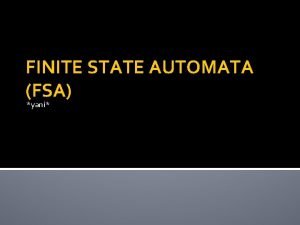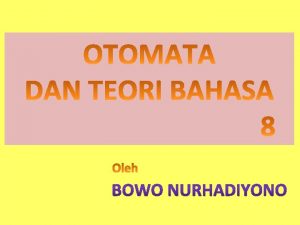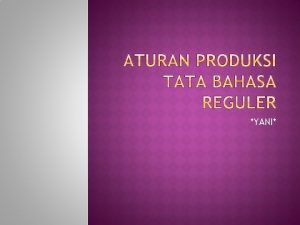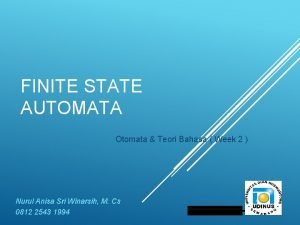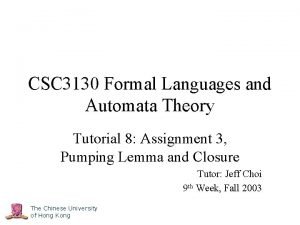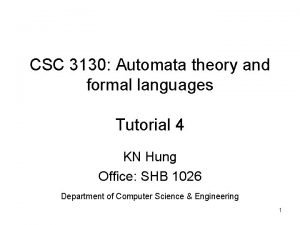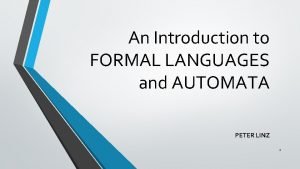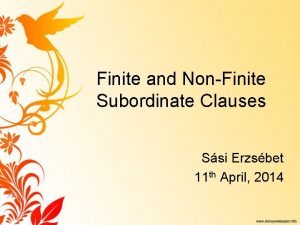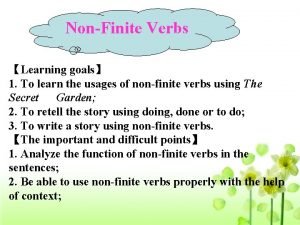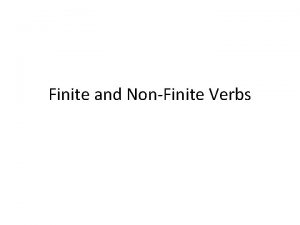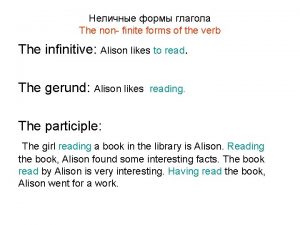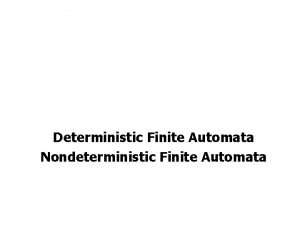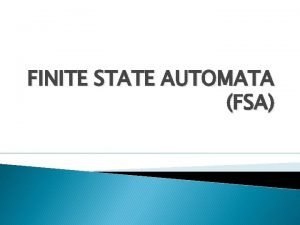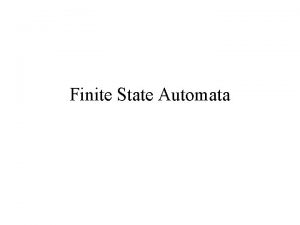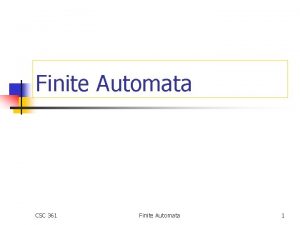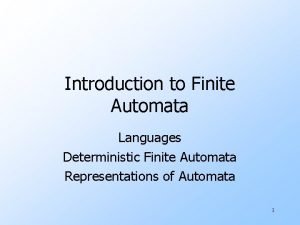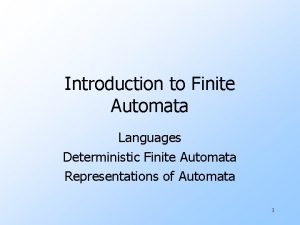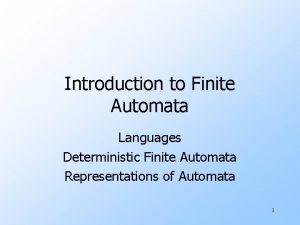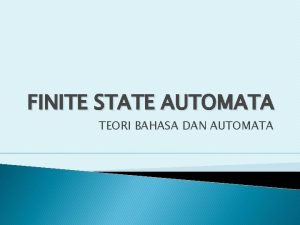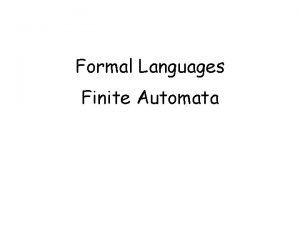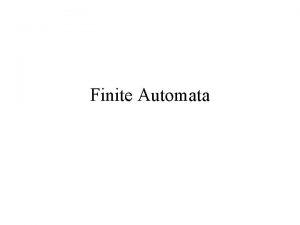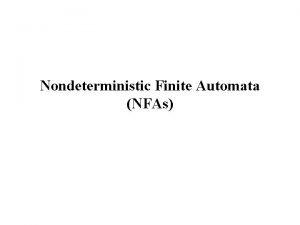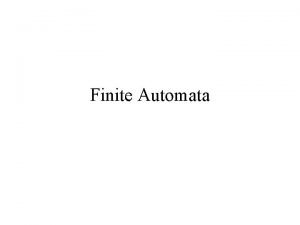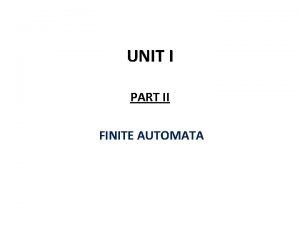Formal Languages and Automata FORMAL LANGUAGES FINITE STATE

















- Slides: 17

Formal Languages and Automata FORMAL LANGUAGES FINITE STATE AUTOMATA

Ex) Vocabulary language boolean ENGLISH(String word) { if { word is in English language } return true; else return false; } Example ENGLISH(‘dog’) would return true ENGLISH(‘xyz’) world return false


Formal Languages The words in the English language can be combined in various ways. The grammar of English tells us whether a combination of words is a valid sentence. The frog writes neatly. follows English syntax because it had a noun phrase followed by a verb phase but doesn’t follow English Semantics (meaning). The syntax of a natural language (English, Spanish, etc. ) is extremely complicated. Sometimes impossible to write all the rules of syntax for a natural language. Research in the automatic translation of some language to another has bead to the concept of a formal language, which unlike a natural language, is specified by a well-defined set of rules of syntax.

Parsing a sentence The large rabbit hops quickly The large rabbit hops <ADVERB> The large rabbit <VERB><ADVERB> The large <NOUN> <VERB> <ADVERB> The <ADJECTIVE> <NOUN> <VERB> <ADVERB> <ARTICLE><ADJECTIVE><NOUN><VERB><ADVERB> <ARTICLE><ADJECTIVE><NOUN><VERB PHRASE> <NOUN PHRASE><VERB PHRASE> <SENTENCE>

Parse Tree <sentence> <noun phrase> <verb phrase> <article> <adjective> <noun> The large rabbit <verb> <adverb> hops quickly

Grammar English (subset) <sentence> <noun phrase> <verb phrase> <noun phrase> <article><adjective><noun> | <article><noun> <verb phrase> <verb><adverb> | <verb> <article> “a” | “the” <adjective> “large” | “hungry” <noun> “rabbit” | “mathematician” <verb> “eats” | “hops” <adverb> “quickly” | “wildly” Key: Terminals non-terminals start symbol the hungry rabbit eats wildly // will parse a mathematician quickly hops // will not parse <adverb><verb> the large hungry rabbit hops quickly // only 1 adjective is allowed

Phrase-Structure Grammar

Phase Structure Grammars

Finite Automata In theory of computation, a branch of theoretical computer science, a deterministic finite automaton (DFA)—also known as deterministic finite accepter (DFA) and deterministic finite state machine—is a finite state machine that accepts/rejects finite strings of symbols and only produces a unique computation (or run) of the automaton for each input string. 'Deterministic' refers to the uniqueness of the computation. - Finite number of states - A start state - Acceptable states (double circle) - Unacceptable states (single circle) - Read input left to right and move from state to state


State = “good” c = read. Next(s); if (c != ‘a’) { state = “no good”; } c = read. Next(s); if (c != ‘b’) { state = “no good”; } while (c == ‘b’) { c= read. Next(s); } // keep reading b’s if (c != ‘a’) { state = “no good”; } c = read. Next(s); if (c != ‘eof’) { state = “no good”; } return state;

a a b b a b a, b

The program needed 1 variable for the state and the ability to read the input string. It’s final state is the output of the program. The FA really did the same thing. The circles are the various states (single circle mean’s “no good” and double circle means “good”) and the arrows tell what state to go to next for each possible input value.

Language notation

Regular Grammar

Regular Language Enumerated
 Contoh soal dan jawaban teori bahasa dan automata
Contoh soal dan jawaban teori bahasa dan automata Diagram fsa
Diagram fsa Fsa dinyatakan dalam 5 tupel, kecuali
Fsa dinyatakan dalam 5 tupel, kecuali Contoh mesin fsa
Contoh mesin fsa Apa yang dimaksud dengan tata bahasa dan aturan produksi
Apa yang dimaksud dengan tata bahasa dan aturan produksi Deterministic finite state automata
Deterministic finite state automata Gambarlah diagram transisi untuk nfa berikut
Gambarlah diagram transisi untuk nfa berikut Formal languages and automata theory tutorial
Formal languages and automata theory tutorial Automata theory tutorial
Automata theory tutorial Formal languages and automata theory tutorial
Formal languages and automata theory tutorial Gtg stands for in automata
Gtg stands for in automata Formal languages and automata theory tutorial
Formal languages and automata theory tutorial Automata theory tutorial
Automata theory tutorial Fused relative clause
Fused relative clause Learning objectives for finite and non finite verbs
Learning objectives for finite and non finite verbs Learning objectives of non finite verbs
Learning objectives of non finite verbs How to find finite and nonfinite verbs
How to find finite and nonfinite verbs Finite and non finite
Finite and non finite

